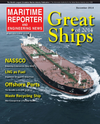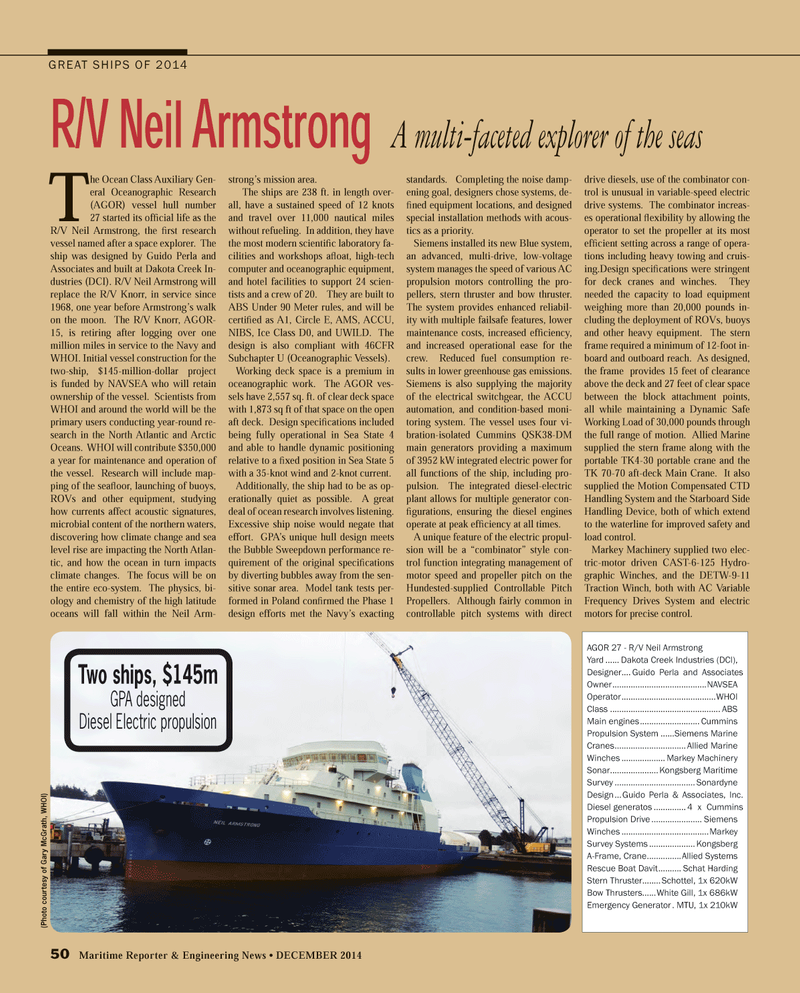
Page 50: of Maritime Reporter Magazine (December 2014)
Great Ships of 2014
Read this page in Pdf, Flash or Html5 edition of December 2014 Maritime Reporter Magazine
GREAT SHIPS OF 2014
T he Ocean Class Auxiliary Gen- eral Oceanographic Research (AGOR) vessel hull number 27 started its offi cial life as the
R/V Neil Armstrong, the fi rst research vessel named after a space explorer. The ship was designed by Guido Perla and
Associates and built at Dakota Creek In- dustries (DCI). R/V Neil Armstrong will replace the R/V Knorr, in service since 1968, one year before Armstrong’s walk on the moon. The R/V Knorr, AGOR- 15, is retiring after logging over one million miles in service to the Navy and
WHOI. Initial vessel construction for the two-ship, $145-million-dollar project is funded by NAVSEA who will retain ownership of the vessel. Scientists from
WHOI and around the world will be the primary users conducting year-round re- search in the North Atlantic and Arctic
Oceans. WHOI will contribute $350,000 a year for maintenance and operation of the vessel. Research will include map- ping of the seafl oor, launching of buoys,
ROVs and other equipment, studying how currents affect acoustic signatures, microbial content of the northern waters, discovering how climate change and sea level rise are impacting the North Atlan- tic, and how the ocean in turn impacts climate changes. The focus will be on the entire eco-system. The physics, bi- ology and chemistry of the high latitude oceans will fall within the Neil Arm- strong’s mission area. The ships are 238 ft. in length over- all, have a sustained speed of 12 knots and travel over 11,000 nautical miles without refueling. In addition, they have the most modern scientifi c laboratory fa- cilities and workshops afl oat, high-tech computer and oceanographic equipment, and hotel facilities to support 24 scien- tists and a crew of 20. They are built to
ABS Under 90 Meter rules, and will be certifi ed as A1, Circle E, AMS, ACCU,
NIBS, Ice Class D0, and UWILD. The design is also compliant with 46CFR
Subchapter U (Oceanographic Vessels).
Working deck space is a premium in oceanographic work. The AGOR ves- sels have 2,557 sq. ft. of clear deck space with 1,873 sq ft of that space on the open aft deck. Design specifi cations included being fully operational in Sea State 4 and able to handle dynamic positioning relative to a fi xed position in Sea State 5 with a 35-knot wind and 2-knot current.
Additionally, the ship had to be as op- erationally quiet as possible. A great deal of ocean research involves listening.
Excessive ship noise would negate that effort. GPA’s unique hull design meets the Bubble Sweepdown performance re- quirement of the original specifi cations by diverting bubbles away from the sen- sitive sonar area. Model tank tests per- formed in Poland confi rmed the Phase 1 design efforts met the Navy’s exacting standards. Completing the noise damp- ening goal, designers chose systems, de- fi ned equipment locations, and designed special installation methods with acous- tics as a priority.
Siemens installed its new Blue system, an advanced, multi-drive, low-voltage system manages the speed of various AC propulsion motors controlling the pro- pellers, stern thruster and bow thruster.
The system provides enhanced reliabil- ity with multiple failsafe features, lower maintenance costs, increased effi ciency, and increased operational ease for the crew. Reduced fuel consumption re- sults in lower greenhouse gas emissions.
Siemens is also supplying the majority of the electrical switchgear, the ACCU automation, and condition-based moni- toring system. The vessel uses four vi- bration-isolated Cummins QSK38-DM main generators providing a maximum of 3952 kW integrated electric power for all functions of the ship, including pro- pulsion. The integrated diesel-electric plant allows for multiple generator con- fi gurations, ensuring the diesel engines operate at peak effi ciency at all times.
A unique feature of the electric propul- sion will be a “combinator” style con- trol function integrating management of motor speed and propeller pitch on the
Hundested-supplied Controllable Pitch
Propellers. Although fairly common in controllable pitch systems with direct drive diesels, use of the combinator con- trol is unusual in variable-speed electric drive systems. The combinator increas- es operational fl exibility by allowing the operator to set the propeller at its most effi cient setting across a range of opera- tions including heavy towing and cruis- ing.Design specifi cations were stringent for deck cranes and winches. They needed the capacity to load equipment weighing more than 20,000 pounds in- cluding the deployment of ROVs, buoys and other heavy equipment. The stern frame required a minimum of 12-foot in- board and outboard reach. As designed, the frame provides 15 feet of clearance above the deck and 27 feet of clear space between the block attachment points, all while maintaining a Dynamic Safe
Working Load of 30,000 pounds through the full range of motion. Allied Marine supplied the stern frame along with the portable TK4-30 portable crane and the
TK 70-70 aft-deck Main Crane. It also supplied the Motion Compensated CTD
Handling System and the Starboard Side
Handling Device, both of which extend to the waterline for improved safety and load control.
Markey Machinery supplied two elec- tric-motor driven CAST-6-125 Hydro- graphic Winches, and the DETW-9-11
Traction Winch, both with AC Variable
Frequency Drives System and electric motors for precise control.
R/V Neil Armstrong A multi-faceted explorer of the seas
AGOR 27 - R/V Neil Armstrong
Yard ...... Dakota Creek Industries (DCI),
Designer .... Guido Perla and Associates
Owner .........................................NAVSEA
Operator .........................................WHOI
Class ................................................ ABS
Main engines .......................... Cummins
Propulsion System ......Siemens Marine
Cranes ............................... Allied Marine
Winches ................... Markey Machinery
Sonar .....................Kongsberg Maritime
Survey ................................... Sonardyne
Design ...Guido Perla & Associates, Inc.
Diesel generatos .............. 4 x Cummins
Propulsion Drive ...................... Siemens
Winches ......................................Markey
Survey Systems .................... Kongsberg
A-Frame, Crane ...............Allied Systems
Rescue Boat Davit .......... Schat Harding
Stern Thruster........Schottel, 1x 620kW
Bow Thrusters ......White Gill, 1x 686kW
Emergency Generator . MTU, 1x 210kW
Two ships, $145m
GPA designed
Diesel Electric propulsion 50 Maritime Reporter & Engineering News • DECEMBER 2014 (Photo cour tesy of Gary McGrath, WHOI)
MR #12 (50-57).indd 50 12/2/2014 2:10:50 PM

 49
49

 51
51
